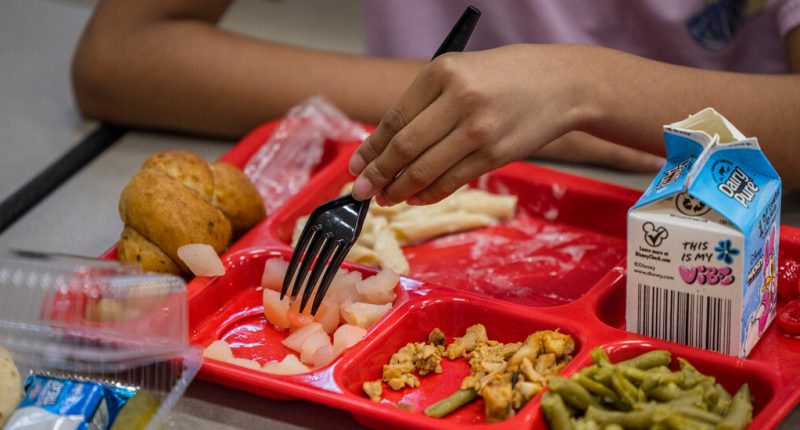School meals will soon contain less salt and sugar, but can still include chocolate milk, under new nutrition guidelines released by the Biden administration.
The Agriculture Department on Wednesday finalized the regulation it had first proposed in February 2023, having weakened several provisions after feedback from food companies, school nutrition professionals and over 136,000 public comments.
“All of this is designed to ensure that students have quality meals and that we meet parents’ expectation that their children are receiving healthy and nutritious meals at school,” Tom Vilsack, the agriculture secretary, said in a call with reporters on Tuesday.
The new guidelines, which seek to better align school meals with federal dietary standards, build on a 2010 law that aimed to make cafeteria breakfasts and lunches healthier. That law, championed by Michelle Obama when she was the first lady, became embroiled in political debate almost immediately. The Trump administration tried repeatedly to roll back nutrition standards, and the Biden administration relaxed certain provisions to provide more flexibility during the coronavirus pandemic.
When the Agriculture Department proposed updates to the standards last year, school nutrition professionals called the guidelines unrealistic to enforce and dairy groups expressed concerns over what they called a push to limit milk.
The final rule reflects some of those concerns.
Under the rule, schools will need to limit the amount of added sugars in cereals and yogurts beginning in the 2025-26 academic year and gradually step up reductions in other foods.
Added sugars currently provide about 17 percent of calories in school breakfasts and 11 percent in school lunches on average, according to a May 2022 government report. Federal dietary guidelines recommend that no more than 10 percent of daily calories come from added sugars.
Schools will need to reduce sodium in lunches by 15 percent from current levels and in breakfasts by 10 percent by the 2027-28 academic year. This was scaled back from a proposed reduction of 30 percent by the 2029-30 school year. Mr. Vilsack said the Agriculture Department was unable to more meaningfully cut salt because it was essentially handcuffed by a policy rider in a spending package Congress approved in March limiting sodium reduction in school meals.
Current standards limit sodium for students in grades K-5 to 1,650 milligrams for breakfast and lunch combined, and the policy rider essentially capped the level at 1,420 milligrams. Federal dietary guidelines recommend no more than 1,500 milligrams of sodium daily for children ages 4 through 8.
Dairy, too, was spared from further reductions. Students can still glug chocolate, strawberry and other flavored milks under the final rule, provided that the beverages meet the limit on added sugars.
Flavored milk was the main source of added sugars in school meals, according to the 2022 government report. The Agriculture Department had considered banning the beverages for grades K-5 under the proposed regulation. But it decided against doing so, Mr. Vilsack said, because the dairy industry “stepped up to the challenge” and is working on making flavored milk products with less sugar.
The final rule also retains the current standard requiring that 80 percent of cereals and legumes offered be whole grains. The department had considered requiring all grains to be whole, with one exception a week for a refined grain product.
Also Read More: World News | Entertainment News | Celebrity News







